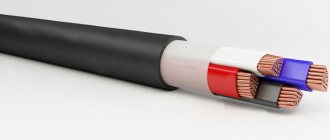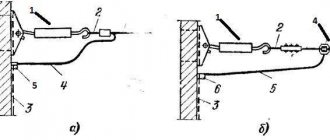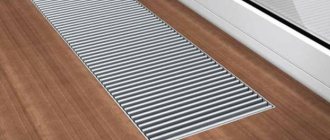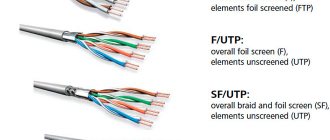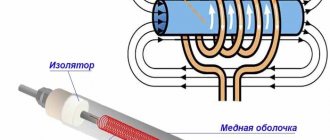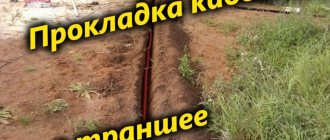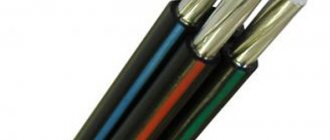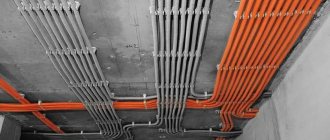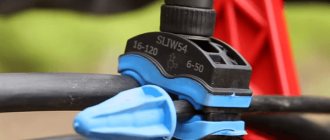The reliability of a power line depends not only on the quality of the components used during its installation. It is important to choose the correct wire cross-section. Errors in calculations and the use of unsuitable materials can lead to breaks, failures, and cause a fire. For open wiring, a special outdoor cable is used that can withstand long-term exposure to sunlight, high humidity and sudden temperature fluctuations.
A special street cable is used for power lines.
Features of outdoor cables
Cables used to transmit electricity outdoors are made of copper and aluminum. They consist of one or more strands, each containing many wires. Thanks to this, the necessary strength and flexibility are achieved.
Insulation material:
- polyethylene:
- PVC;
- rubber;
- lead.
The design of cables designed for heavy loads contains steel alloys. They increase their service life.
Such products have improved characteristics.
Wire characteristics
The maximum permissible temperature range in which the line operates is from – 60 to + 50 °C. The service life of the wires reaches 10 years or more.
Such conductors are made with improved insulation. Thanks to it, they not only withstand exposure to ultraviolet radiation and severe frosts, but also have an increased threshold of resistance to mechanical damage.
Elements and device
Inside the cable there is one or more metal conductors covered with insulation. Aluminum and copper are used as conductors. Some models have reinforced structures supplemented with steel wire.
One core can consist of many wires of small cross-section, or it can be made from a single wire of a larger diameter.
At the dacha or if it is necessary to extend a line from the house to the yard to buildings, copper wires are used. Under the insulation of a multi-core high-voltage cable there is a shielding metal layer. It can be lead, aluminum or their alloys.
Requirements according to GOST
GOST sets strict standards that cables for street wiring comply with.
Street Wiring Standards
| Cable brand | GOST |
| SIP | 31946-2012 |
| AVBbShv | 16442-80 |
| NYY | The cables can be used along with VVG and VVGz wires for a voltage of 1 kV according to GOST 16442-80. In terms of design, technical characteristics and operational properties, they comply with German standards DIN VDE 0276 part 603 and DIN VDE 0276 part 627 |
| PVS | 7399-97 |
| VVG | 16442-80 |
| PV | 6323-79 |
| Automatic reclosing | 6323-79 |
In accordance with GOST, the cores of fire-resistant wires are made of copper wire with a cross-section from 1.5 to 2.2 mm. A thermal barrier made of mica-containing tapes is placed on top of them, then a screen and only then insulation.
The tensile strength of the cord must be no less than 60 and no more than 90 N/mm2.
For insulation the following are used:
- polyvinyl chloride plastic compound;
- polyethylene;
- polymer composition without halogens.
The nominal thickness of the core, depending on the brand of the cord, should be in the range from 1.5 mm to 16 mm.
The insulating material must have different colors. Moreover, its color depends on the serial number in the design.
Cable markings
The letter index contains data about the metal from which the cores are made. It contains information about insulating material and protection.
Marking order:
- The metal from which the conductor is made.
- Purpose of the product.
- Insulation.
- Protection.
The marking also contains a number of numbers that indicate the number of cores and their cross-section.
The latter indicates the rated voltage class. By material
| Letter | Meaning |
| A | Aluminum |
| – | Absence of the letter “A” means copper is used |
By purpose
| Letter | Meaning |
| Sh | Installation |
| TO | Control |
| M | Mounting |
By insulation
| Letter | Meaning |
| P | Polyethylene |
| N | Heat resistant rubber |
| IN | PVC |
| TO | Capron |
| Ps | Thermoplastic polyethylene |
| WITH | Lead |
| Pv | High quality polyethylene |
By degree of protection
| Letter | Meaning |
| B | Armored shell |
| G | Has no protection |
| A | Asphalted |
For example, the VVG cable does not contain the letter A in the marking. This means that copper is used as a conductor. The first B indicates the type of core insulation - polyvinyl chloride, the second B - the sheath material that protects the entire wire. The last symbol G warns that the product does not have armor or additional protective coverings.
Briefly about the main thing
An outdoor cable for conducting electricity across a site consists of one or more cores, each of which, in addition to the common one, has an individual insulating sheath. Unlike a conventional conductor, such a cable must reliably withstand wind, temperature changes, and solar radiation.
When choosing a cable for specific application conditions, its properties must be taken into account - for which the marking is used. It indicates the type of core material, purpose, shell material, design features. The most commonly used types of outdoor cable are:
- SIP.
- AVBbShv and VBBbShv.
- NYY.
- NYM.
As alternative options, PVS, VVG VBbvng, PV, APV, PV1 and other wires can be used. For external cable wiring, three methods are used - overhead, along the facade and underground. When laying electrical wiring, safety rules must be followed.
Types of outdoor cable
The wire for external wiring must withstand heavy loads, sudden temperature changes and wind. For such lines it is necessary to use reinforced cables of special brands.
SIP
SIP is a cable designed for wiring lines on the street. Consists of several aluminum cores. They are collected in one group and covered with black insulation.
SIP - cable for outdoor wiring.
Produced without an armored shell. It is characterized by increased reliability. Characterized by relatively low cost. It is mainly used for laying high-voltage overhead lines. Due to its flexibility and compactness, it can be mounted on a wall or in another non-standard way.
AVBbShv
Armored cable made of aluminum conductors. Used for laying lines in the ground. There is an option with a copper conductor - the first letter A is missing in its designation.
It is highly resistant to moisture and can be used in harsh climatic conditions for up to 30 years
The use of the product is limited due to the complexity of installation. The cable has increased rigidity, but has a high level of protection.
NYY
The wire is made with copper and aluminum conductors. It is universal: it can be laid underground, draw lines through the air and even be used indoors.
The product has black PVC insulation, and the core sheaths are painted in different colors. The cable is resistant to aggressive environments and open fire. Service life reaches 30 years.
NYY cabul can be laid underground.
PVS
The wire is used for external wiring. Consists of several copper wires covered with multi-colored insulation. Very flexible, suitable for wall mounting and installation in hard-to-reach places.
Characteristics:
- rated voltage – 660 V;
- number of cores – 2–7;
- service life – from 2 to 15 years.
The cable can operate at humidity levels up to 98%. Temperature range – from -25 to +40 °C.
Two-core PVS wire is often used in private homes for street lighting. It is used for laying wiring from the main building to outbuildings.
VVG
A copper wire having one or more single copper strands coated with multi-colored insulation. Cable with black plastic sheath. Rated voltage – from 660 to 1000 V.
Suitable for outdoor wiring. Can be used indoors. Temperature range – from -50 to +50 °C.
VVG has several single copper cores.
Increased flexibility makes installation easier, but such a conductor is poorly protected from external mechanical influences.
PV and AR
Cables of this brand are used for wiring in rooms where exposure to aggressive environments is reduced to zero. They can be used outdoors only inside pipes that will provide the necessary protection for the line.
Rated voltage – up to 450 V. Temperature range – from -50 to +35°С. The service life can reach 15 years.
Alternative wiring
When organizing an external electrical network in conditions of shortage or absence of main types of conductors, it is permissible to use alternative ones:
- PVS. Flexible conductor with PVC insulation, equipped with 2-5 cores.
- VVG. Flat cable with double sheath, equipped with 1-5 internal conductors.
- PV, APV, PV1, etc. Acceptable for external installation - but subject to installation in protective pipes, casings, corrugations. The main disadvantage is the single shell.
- VBBbvng. Fire-resistant flexible cable, equipped with 1-6 cores.
To lay the cable in the ground, a trench 0.5-0.7 meters deep is prepared Source ytimg.com
Reference! The longer the power line, the higher the current loss due to the resistance of the wiring material. Therefore, the longer the network, the larger the cross-section of the cores should be. To calculate the parameter, special formulas are used.
Wires for special purposes
Where the environment is most aggressive, special cables are used that have increased resistance to frost, high temperatures and mechanical stress. Such wires may be needed in a bathhouse, cellar, or when laying a line near stoves.
Non-standard SIP
SIP cables are available in several versions. The markings of such wires contain a number. It denotes one class or another:
- SIP-1. Such a cord consists of several cores, and the zero one has no insulation.
- SIP-2. Two-core cable with insulated zero. Used for laying overhead lines. Has protection from moisture and open fire. Can be used at temperatures up to +900 °C.
- SIP-3. PVC insulated cable. Not suitable for harsh environments.
- SIP-4. Wire with 2 or 4 cores. Used for indoor and outdoor wiring.
- SIP-5. Non-standard wire with improved protection and double insulation. Can be used for laying lines over long distances.
The rated voltage of reinforced structures can reach 20 kV.
Decorative wiring
To ensure that the wiring fits seamlessly into the design of a country house or cottage, decorative cables are used. They have a vintage look, and over the insulation they have a silk braid made of non-flammable material.
Expensive branded cables are made with porcelain insulation. Products from companies such as Gl Gambarelli and Fontini are considered the best on the market.
Cable laying options and their features
There are 3 main ways to lay a cable in a country house or adjacent area of a private house - laying it by air on the street, installing it along the facade of a structure, and burying it in the ground. Each option has its pros, cons and application features:
- Air. To conduct a line over the air, a SIP cable is most often used, less often a VSG cable. The wire sheath is made of cross-linked polyethylene and is not destroyed by sunlight, wind and temperature changes. The first type of cable has aluminum conductors, the second has copper conductors.
The advantages of this method are high speed of installation, ease of inspection and maintenance. The disadvantage is the impact on the design of the territory, the need to use a durable and resistant to external factors conductor, and sometimes the mandatory installation of a steel installation cable.
Aerial cable wiring on an installation cable in a protective corrugation Source samelectrik.ru
- Along the façade. The method is used when it is necessary to connect equipment located on external walls - most often a lamp. However, it is not necessary to use a durable self-supporting cable to lay the network. Since it will not hang freely in the air, but will rest on the facade.
At the same time, such a conductor will need all the protection from destruction. Therefore, protective corrugation based on polyamide or metal is used for installation. Materials must also be resistant to sunlight and temperature changes.
- Underground.
The method is suitable when it is necessary to conduct an electrical network over a sufficiently long distance. It has the following number of advantages:
- Unaffected by UV radiation and wind.
- Does not affect the design of the territory.
- Does not interfere with the operation of the site.
It also has some disadvantages:
- There is a high probability of damage due to soil pressure and shifting layers.
- The line can also be affected when developing the soil on the site - digging a well, a trench for a foundation, etc.
- Impact of biological factors – damage by rodents.
- Getting wet due to rising groundwater or flood waters.
Which cable is better to choose?
The choice of wire brand depends on the specifics of their application. Copper flexible cords are suitable for lines that are pulled over short distances. Their defense is weak. But they are inexpensive. They are easier to install and maintain.
A boiler room or bathhouse can be electrified using cords designed for heavy loads. The wires must be protected from high temperatures indoors and from frost or sun outdoors.
The choice of cable depends on the specific application.
For high voltage lines hundreds of meters long, non-standard SIPs are used. They can either be laid underground or carried through the air.
What to choose for telephone lines
Outside the premises, telephone lines are laid underground, protecting the wires with special structures or stretching them inside pipes. It is also possible to lay the cable over the air.
For wiring on the walls of houses, products of the following brands are used: TPVBG, TPPep, PRPPM. And for underground and overhead lines - TCPP(v)t, TCPPmPt, PRPPMt, PRPPMS, TB, TK, TPPepB, TPPepZBbShp, etc.
For home wiring, simple products without armor or screens are used. The insulating material of such cables is PVC or rubber, and their service life can reach 15 years.
Wire and cable insulating component
An integral part of cable and wire products is the insulation of the metal current-carrying base. The purpose of insulation is quite clear - to ensure an isolated state for each current-carrying core, preventing the effect of a short circuit.
The insulating material in most cases is polyvinyl chloride, which has shown in practice quite acceptable qualities in the construction of widespread electrical networks.
Depending on the purpose of the cable (wire) products, the insulating part may have different designs.
The dielectric material can be:
In addition to purely electrical protection, the insulating material also provides mechanical protection, protecting the electrical wire (cable) from moisture and other destructive factors.
There is also a special insulating construction applied to electrical wires and cables, giving the products "armored" or "anti-chemical" properties.
Special design - “armored”, reliably protects the internal structure, prevents moisture penetration, acts as a buffer against mechanical overloads
Negative factors for external wiring
Power line structures that are located outside residential premises are constantly exposed to a number of negative impacts. They can suffer mechanical damage and lose elasticity from overheating under the sun. There is a risk of wires breaking due to strong gusts of wind.
Ultraviolet
When heated under sunlight, the wires become more elastic and bend more. If the structure was assembled incorrectly, then in extreme heat and wind this can lead to a line break.
Under sunlight, the wires bend more.
Under intense exposure to ultraviolet radiation, the insulating material gradually deteriorates. It becomes fragile and sensitive to mechanical damage.
Humidity
If the cable is poorly waterproofed, the wiring may short out. In some cases, such situations lead to fires.
If it is necessary to lay the line underground or in places where there is a lot of moisture accumulation, then it is necessary to use special grades of wires.
frosts
In extreme cold, metal conductors and insulating layers lose their elasticity. If the product is not designed to withstand such conditions, cable sheath failure and short circuits may occur.
In extreme cold, the wires lose their elasticity.
The effect of cold must be taken into account when installing flexible wires along the walls of residential premises. In winter, ice may form there, which under its weight can damage the line.
Wind
You can avoid destruction of overhead power lines in gusty winds if you use cables that have increased cord breaking strength. According to GOST for power wires it should be no less than 60 and no more than 90 N/mm².
If weather conditions mean windy weather all year round, then it is worth considering the option of laying underground communications.
Cable laying methods
Electrical wire for outdoor wiring can be installed in several ways. The most popular is open, when the line is pulled through the air or along the wall. Sometimes it makes sense to run the cable underground.
By air
For this method, it is necessary to select wires that can withstand heavy loads created by tension and sagging. Insulation must be designed for constant exposure to the external environment: wind, frost, sun.
Wires must withstand heavy loads.
To supply electricity by air within private housing constructions, use SIP-4 cable or its analogues.
Laying technology:
- A steel cable with a diameter of 4–5 mm is stretched between the line supports using hooks, lanyards, pulleys or other devices.
- The cable is placed in a protective corrugation and attached to a tensioned cable.
The distance between the supports should not exceed 25 m. If the cable sags after adjusting the tension, you will need to install intermediate supports.
Along the wall
The most common wiring method in private homes is to install the cable along the wall of the building.
When laying, the following distances must be observed:
- at least 275 cm above the ground;
- 30 cm above windows and doors;
- 100 cm to the edge of the balcony;
- 50 cm under windows and balconies.
The SIP grade wire must be at a distance of at least 6 cm from the wall. This is due to the fact that the cable does not have an insulating protective layer. PVC sheathing is present only on individual cores. This material is flammable and in the event of a short circuit the fire can spread to the building.
Laying technology:
- The point where the cable exits the facade is selected and an anchor bracket is installed nearby at a height of 2.75 m from the ground.
- The cable is secured to it using a clamp.
- Along the wall, the wire is fixed with facade clamps secured with screws and self-tapping screws.
The use of homemade fittings, clamps for plastic pipes and other devices is not allowed.
In the ground
For underground lines laid in neutral soil, AVBbShv cable is used. Armored insulation reliably protects wiring from moisture and aggressive substances. If the soil consists of construction waste or slag, then it is better to use cords AABL, AAShv, AAB2l, ASB and their analogues.
Laying technology:
- Remove rocks, tree roots and any sharp objects from the trench.
- Level the bottom, eliminating sudden changes.
- Pour a layer of construction sand and compact it.
- Lay the cable, avoiding strong tension.
- Cover with a layer of sand up to 10 cm.
- Place a layer of soil and warning tape on top of it.
- Backfill the trench.
The width of the ditch must be at least 30 cm, and the depth - up to 70 cm.
Brief recommendations on the installation method
Another factor that must be taken into account is the installation method. The most popular options:
- Air. This option is suitable for cases where the cable has a length of 3 meters or more. The advantages of the method are high installation speed and ease of maintenance. On the other hand, aesthetics suffer and the service life of the product decreases. In the process of such installation, a steel cable is used, to which the cable itself is attached using ties.
- Underground. This method is used in most cases when it is necessary to lay a long cable. Installation is carried out in several stages - choosing the cable type, marking the location and laying it. The depth of the trench is about 70 cm. At the bottom there should be a “cushion” of sand about 8-10 centimeters thick. The cable must be laid without tension, after which it is covered with sand, soil and finally compacted.
An example of cable laying in a trench is shown in this video:
Rules for laying street cable
When wiring lines, it is necessary to take into account the installation rules. Neglecting them leads to unforeseen consequences. Wires laid in violation of regulations can quickly fail or cause a short circuit.
By air - distance between buildings
When laying wires outdoors in the air, it is necessary to maintain a distance between supports of 25 m. If the lines sag, it can be reduced to 10 m. It should be borne in mind that excessive tension can lead to a break in strong winds or snowfall.
The line should be located away from massive structures and trees that could damage it in the event of bad weather.
The distance between the entrance to the house and the first support should be within 2.5–3 m, and from the balcony or window - at least 1 m.
When laying wires through the air, you need to maintain the distance.
Along the walls
You cannot lay wires on the roof and run a line without a cable with a corrugated sleeve. All connections must be protected, switches, meters and other elements must be transferred to a sealed box.
Do not fasten wires using twists. To do this, you must use factory brackets and clamps. Saving on safety is inappropriate.
Laying underground
This method is labor-intensive and expensive. But its durability and reliability are much higher. The method is used when it is necessary to connect buildings located at a great distance from the power source. Cables with increased protection of the AVBbShv brand should be used.
The trench should be no closer than 60 cm from residential buildings. Do not dig it directly near trees to avoid possible damage to the line by roots.
When installing the wire, you need to lay the signal tape above the cable.
Laying wires underground is a labor-intensive method.
This will allow you to avoid an accident if you have to carry out excavation work in this area.
Rules for installing outdoor wiring
When choosing a wire for external wiring, it is important to take into account the features of its laying. There are a number of rules regarding protection and distance from residential buildings. So, the distance from the cable to the porch should be at least 250 cm, and to the balcony or window - 100 and 50 cm, respectively. If the wiring is vertical, the distance from the ground surface should be 275 cm, to the balcony or window opening - 100 and 75 cm, respectively.
If the wire is laid along the wall, you should follow a number of rules:
- In the case of using individual wires, the use of plastic or metal pipes is mandatory.
- The connection of the wires must be ensured using terminal blocks (twisting is prohibited).
- When hanging a cable between buildings, it is necessary to use a cable and a corrugated sleeve.
- Wire connections should only be made in sealed junction boxes.
- Installation of wiring on the roof is prohibited.
When laying wires on the street, it is worth considering a number of important nuances. Thus, the network of a private home can be connected to a power source of 3 or single-phase voltage (380 or 220 Volts, respectively). If wiring is done by air, it is recommended to use SIP-4 wire.
Armored wires of the VBShv or AVBShv brands are more suitable for underground installation. A special feature of such products is their resistance to water and mechanical damage. For external wiring, as a rule, wires with an aluminum core of larger cross-section are used, which reduces installation costs.
Which laying method to choose
The length of individual sections of the line, design cable cross-sections and environmental conditions are the decisive factors that determine the choice of installation method. It is necessary to carry out installation in such a way as to prevent destruction of the conductor insulation and damage to structural elements.
Sometimes it is appropriate to use combined methods. For example, if you need to supply electricity from a pole to a country house. Then the line can go through the air to the building, and then along the wall.
In harsh climatic conditions, it is better to lay the line underground. This also applies to the installation of high-voltage cables over long distances.
How to calculate the load on electrical wiring
Knowing the total power that the equipment should consume in the entire room, you can calculate the load on the power line.
Knowing the total power, you can calculate the load on the power lines.
The minimum value will be equal to the sum of the powers of all energy consumers in the house, multiplied by a factor of 0.8, and the maximum by 1.2.
The formula looks like this:
(P1+P2+P3+…Pn) * 0.8 = P,
where Pn is the power of the electrical appliance in the house, and P is the permissible load on the wiring.
How to lay a wire between living spaces
Laying wires between houses is possible in 2 ways - by air or underground. Part of the overhead line can run along the facade of the building.
Between buildings that are close to each other, you can find a line of simple wires. Often they are stretched from one house to another without grounding and compliance with regulations. Such installation can lead to breaks and fire.
Is grounding necessary?
Special clamps, which are used to secure the wire to the overhead line cable, have connectors for connecting portable measuring instruments. You can also connect a mobile protective ground there.
Grounding is performed before tensioning the wire.
The TN-CS system (transformer substation with solidly grounded neutral) consists of 2 or 4 SIP cables. They are used for overhead power line wiring. One conductor is considered the main conductor (PEN), the rest are phases. PEN is divided into two wires - protective zero (PE) and working zero (N).
Grounding is performed immediately before tensioning the wire on the support. For this purpose, steel wire is used. Its diameter should not be less than 6 mm. In concrete pillars, metal reinforcement is located inside the structure.
Housings of lamps, panels and other metal structures must be connected to the zero phase.
Preparation
After carrying out the necessary calculations, the cable cross-section is determined. The brand is chosen based on the method of laying the line. For overhead you will need SIP, and for underground - AVBbShv.
Before starting work, you need to uproot stumps and remove any foreign objects along the route, collect and prepare the necessary tools. Then you need to purchase the required amount of wire and elements for its fastening.
Posting by air
For wiring, old poles should be removed, if necessary, and new ones installed. Securely fix all fastening elements on them and ensure grounding.
The cable is raised to a height and tensioned using rollers.
The cable is sold in reels. Before installation, it needs to be rolled out, but not on the ground. For this purpose, special rolling carts are used. Otherwise, the insulating layer of the conductor may be damaged.
The cable is raised to a height. Then they are tensioned using rollers. After fixing the wire with anchor clamps, they are removed. A team of workers is required to complete this work. Special equipment may be required.
Deep installation
Special attention should be paid to the choice of cable. For swampy areas or soil with a high salt content, reinforced armored wire will be required.
At a distance of at least 60 cm from the building, a trench is dug up to 130 cm deep and at least 30 cm wide. Its bottom is leveled with a layer of sand, which must be filled to a depth of 10 cm. A cable is laid on top of it without tension. It should lie freely.
Another layer of sand is poured over the wire and fresh soil is laid, leaving 15–20 cm for the signal tape. Then the trench is buried to the end.
Along the walls of the building
From the living room the cable is routed to the wall. There it is attached with special clamps to the brackets. The wiring along the wall is fixed with clamps.
The procedure for attaching the cable:
- On the facade of the house, holes are drilled in the right places into which dowel-nails (plastic clips made from a cap and a screw) are inserted.
- Dowels are used to secure brackets to the wall and clamps.
- Install the wire.
Copper flexible wires of low rated voltage can be laid inside a metal pipe attached to the facade of the building.
How to dispose of wire after use
All cables are made of copper and aluminum. Some brands contain steel and lead. Non-ferrous metal can be handed over to collection points and you can get money for it. But you will have to burn the insulation over an open fire.
Insulated colored wire, from which the cores of some brands of cables are woven, can be used to weave key chains and small jewelry.
Industrial recycling consists of several stages:
- the cables are sorted and cut into small pieces of 20–40 mm;
- after magnetic separation, they are chopped using special crushers into pieces measuring 4–8 mm;
- After separating the metal from the insulation, the metals are removed and packaged into pressed briquettes.
Copper and aluminum are sent for smelting, and insulating materials are disposed of separately. Plastic is processed in specialized factories.
